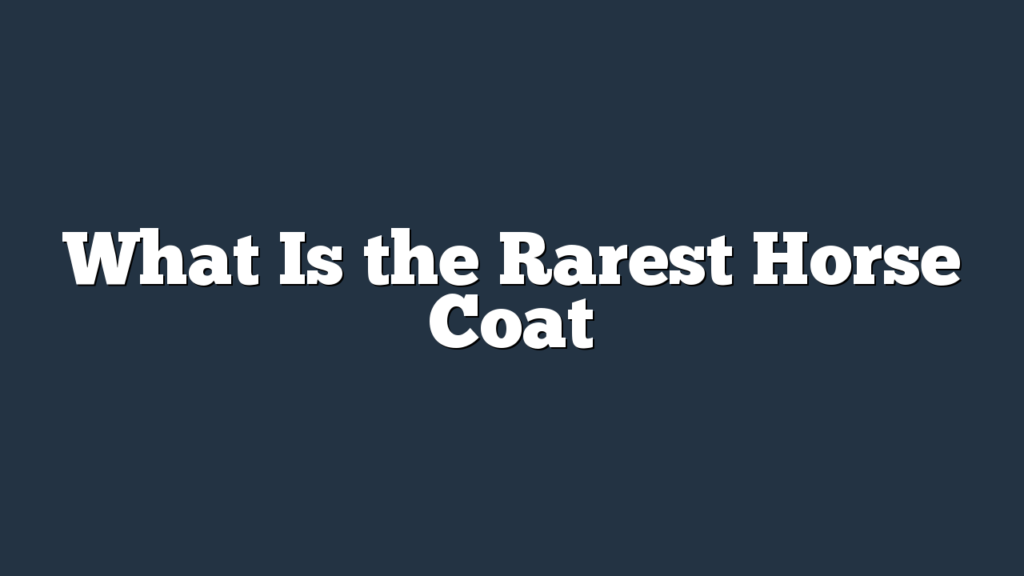Do you ever wonder what the rarest horse coat is? Well, look no further!
In this article, we’ll explore the most elusive horse coats out there. From the elegant Champagne coat to the enchanting Pearl coat, we’ll delve into the world of these rare and beautiful equine colors.
Discover the distinctive Silver Dapple, the striking Grullo, the captivating Roan, and the mesmerizing Sabino coats.
Get ready to be amazed by the rarest horse coats you’ve ever seen!
Champagne Coat
The champagne coat is considered one of the rarest horse coats. What’re the genetic traits that determine a champagne coat?
Well, the champagne coat is a result of a specific gene called the Champagne Dilution gene. This gene affects the production of pigment in the horse’s hair, resulting in a unique coat color. Unlike other rare horse coats, such as the cremello or perlino, which are caused by the cream gene, the champagne coat has its own distinct genetic trait.
The champagne coat is characterized by a pale, metallic sheen that gives the horse a golden or champagne-like appearance. This coat color can vary from a light champagne to a darker, richer shade. Additionally, the champagne coat often comes with lighter colored skin, eyes, and hooves, which further enhance its uniqueness.
One interesting aspect of the champagne coat is that it can interact with other coat colors to create even more variations. For example, when combined with a bay coat, it produces the classic champagne color, while when combined with a chestnut coat, it creates a unique shade known as amber champagne.
Pearl Coat
To understand the rarity of the pearl coat, you must delve into its unique genetic characteristics. The pearl coat is the result of a specific gene known as the ‘pearl dilution’ gene. This gene acts on the black pigment in a horse’s coat, diluting it to a pale, creamy color. Horses with the pearl coat display a range of shades, from a light cream to a golden hue, often with a metallic sheen.
The genetic origins of the pearl coat can be traced back to the ancient Arabian horse breed. This unique coat color has been prized for centuries and has gained significance in horse breeding due to its rarity and beauty. Horses with the pearl coat are highly sought after for their striking appearance and their ability to pass on the dilution gene to their offspring.
Horses with the pearl coat possess several unique characteristics and traits. Besides their distinct color, they often have lighter skin and eye colors, giving them a truly ethereal appearance. These horses also tend to have a gentle and calm temperament, making them ideal for various disciplines, including dressage and trail riding.
Silver Dapple Coat
Now let’s delve into the unique characteristics of the silver dapple coat, carrying on from the discussion of the pearl coat.
The genetics behind the silver dapple coat are fascinating. This coat color is caused by a mutation in the gene called the PMEL17 gene. This gene is responsible for producing a protein called melanophilin, which plays a crucial role in the production of pigment in the hair. The mutation in the PMEL17 gene affects the way this protein is produced, resulting in a dilution of the black pigment.
Horses with a silver dapple coat have a stunning appearance. Their coat color ranges from a pale silver to a dark chocolate brown shade. The most distinctive feature of the silver dapple coat is the presence of dappling, which are lighter spots scattered across the body. These dappling patterns give the horse a unique and eye-catching appearance.
In addition to their stunning coat color, horses with a silver dapple coat often have other unique characteristics. They tend to have a thick and luxurious mane and tail, which adds to their overall appeal. Many silver dapple horses also have light-colored or amber eyes, which further enhances their striking appearance.
Grullo Coat
Continuing from our discussion of the silver dapple coat, let’s explore the unique characteristics of the grullo coat. Grullo horses, also known as grulla or blue dun, have a stunning coat color that sets them apart from other horses. This rare coat color is the result of a specific set of genetic factors.
Exploring the genetics behind grullo coats, we find that they are the product of the dun gene combined with the black or bay base coat color. The dun gene dilutes the base coat color and creates a smoky appearance, while also causing primitive markings such as dorsal stripes and leg barring. The end result is a horse with a striking coat that ranges from a smoky gray to a silvery blue.
To paint a clearer picture, let’s take a look at the following table:
| Coat Color | Base Color |
|---|---|
| Grullo | Black or Bay |
Now, let’s uncover the historical significance of grullo horses. These horses have a rich history, as they were highly valued by Native American tribes for their strength, endurance, and versatility. They were often used for hunting, transportation, and war. Today, grullo horses continue to captivate horse enthusiasts with their unique coat color and their connection to our shared history.
Roan Coat
Roan horses exhibit a unique and rare coat color pattern. The origin and genetics of the roan coat can be traced back to a single gene known as the Roan gene. This gene causes the intermingling of white and colored hairs, resulting in a distinctive speckled or mottled appearance. The roan coat can be found in various horse breeds, including Quarter Horses, Arabians, and Thoroughbreds.
The distinctive characteristics of the roan coat include a base color, such as bay, chestnut, or black, with evenly scattered white hairs. Unlike other coat patterns, the roan coat doesn’t change with age or seasons. The amount of white hairs can vary, with some roan horses having a few scattered white patches, while others have a nearly completely white coat.
The genetics of the roan coat are fascinating. When two roan horses are bred together, there’s a 25% chance of producing a non-roan foal, a 50% chance of producing a roan foal, and a 25% chance of producing a homozygous roan foal. Homozygous roans have two copies of the Roan gene, and their offspring will always inherit a roan coat.
Sabino Coat
As we delve into the topic of rare horse coats, let’s explore the captivating Sabino coat, which adds another layer of uniqueness to the already fascinating world of equine color patterns. The Sabino coat is characterized by its white markings, which can range from small specks to extensive patches. These markings are caused by genetic variations and inheritance of the sabino coat. Unlike other coat patterns, the Sabino gene doesn’t dilute the base coat color, but rather modifies it, resulting in a striking contrast between the white markings and the base color.
The cultural significance of the Sabino coat varies among different horse breeds. In some cultures, horses with Sabino coats are believed to possess magical or mystical powers. These horses are often considered sacred and are highly revered. In other cultures, the Sabino coat is valued for its aesthetic appeal and is sought after in the show ring. Breeders carefully select horses with Sabino coats to produce offspring with these unique markings.
Frequently Asked Questions
How Are Horse Coat Colors Determined Genetically?
Horse coat colors are determined genetically. The genetic basis involves specific genes that control pigmentation. Inheritance patterns play a role in passing on coat colors from parents to offspring.
Are There Any Health Concerns Associated With Rare Horse Coat Colors?
Rare horse coat colors, like the champagne or pearl coats, arise from specific genetic origins. However, it’s important to note that these unique colors can sometimes be accompanied by potential health concerns, such as skin sensitivity or eye issues.
Can Horse Coat Colors Change Over Time?
Horse coat colors can be influenced by environmental factors, such as exposure to sunlight. Additionally, through breeding techniques, horse coat colors can be artificially altered. So, yes, horse coat colors can change over time.
Are Rare Horse Coat Colors More Desirable in Certain Equestrian Disciplines?
Rare horse coat colors can be more desirable in certain equestrian disciplines. In show jumping, they can make a horse stand out. In Dressage and Western riding, they can add elegance. However, horse coat color is not important in horse racing.
Are There Any Specific Breeds That Are More Likely to Have Rare Coat Colors?
Certain horse breeds are more likely to have rare coat colors due to genetic factors. These specific breeds possess unique genes that contribute to the rarity of their coat colors.
Conclusion
So there you have it, the rarest horse coat can vary depending on the breed and genetic factors.
The champagne, pearl, silver dapple, grullo, roan, and sabino coats are all considered rare and highly sought after by horse enthusiasts. Each coat has its own unique characteristics and appeal.
Whether you’re a horse lover or just curious, exploring the world of rare horse coats can be a fascinating journey.



